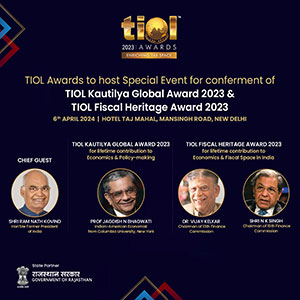Time for equitable tax rates in place of slab rates that tax higher income disproportionately lesser and lower income more!
JANUARY 29, 2008
By Subhashree Kishore
EVEN as Delhi shivers in cold wave, the North Block is probably warming on a teeming, beaming cup of joy, for tax collections are up by 40% and direct taxes at that. So have Indians become more prosperous, honest and law-abiding? Perhaps yes. There is also optimism among tax-payers that the FM will keep his promise of simplification of tax laws and easing of tax burden now that compliance has improved. Of course, corporates, their organized associations and professionals are probably ready with their wish list - respectably labeled ‘suggestions’. Despite the sporadic enhancement of threshold limits and progress towards a three-tier system on par with world economies there is still much to be done to make personal income tax sufficiently ‘personal’ rather than apathetic as it is viewed to be now. This write-up proceeds to propose a few changes aimed at easing the squeeze of individual assessees, more particularly the salaried class.
Premises
- Adam Smith’s cannons of taxation call for equity (or equality of sacrifice), certainty (clarity of rules), convenience (ease of compliance) and economy. Other features like flexibility, neutrality and efficiency in collection are also now held as desirable.
Direct taxation – on income is to be progressive meaning it increases as incomes increase and serves as a tool of redistribution, seeking to curb the ill effects of concentration of wealth and wasteful consumption.
Despite various studies, unanimity on why people pay taxes or do not, is seen. The latter (Why should I pay or what do I get by paying taxes) may be explained with high rates, Laffer curve and lack of perceived tangible benefits flowing from compliance but the current buoyancy defies these contentions. The former (I have no other option but to pay up) is said to be affected by a range of factors, including deterrent penal provisions, efficiency of tax administration, costs of evading and community values.
Revisiting tax slabs and rates
Let us first examine the rates and brackets. In the current scenario we find that the initial or base rate of 10% applies on Rs.40,000 (between Rs.1,10,000 and 1,50,000) and 20% on a mere Rs.1,00,000 (between Rs.2,50,000 and 1,50,000). Even while the maximum marginal rate of 30% on incomes above Rs. 2,50,000 compares evenly with similar economies like China and Korea, the incomes do not. The 30% rate is applicable on income above Rs. 37,00,000 (approx) in China (our current role-model for development) while the limit is Rs.28,00,000 (approx) in South Korea. That the Indian tax structure is hardly progressive can well be seen from the following table. This is a simple layman analysis bereft of the paraphernalia of a task force or a study group.
Income | Tax | Tax rate | Post-tax income | Percentage of post-tax income | Tax paid % | Increase over previous slab |
100000 | 0 | 0 | 100000 | 100.00 | 0.00 | 0.00 |
110000 | 0 | 0 | 110000 | 100.00 | 0.00 | 0.00 |
120000 | 1000 | 10 | 119000 | 99.17 | 0.83 | 0.83 |
130000 | 2000 | 10 | 128000 | 98.46 | 1.54 | 0.71 |
140000 | 3000 | 10 | 137000 | 97.86 | 2.14 | 0.60 |
150000 | 4000 | 10 | 146000 | 97.33 | 2.67 | 0.52 |
200000 | 14000 | 20 | 186000 | 93.00 | 7.00 | 4.33 |
250000 | 24000 | 20 | 226000 | 90.40 | 9.60 | 2.60 |
300000 | 39000 | 30 | 261000 | 87.00 | 13.00 | 3.40 |
350000 | 54000 | 30 | 296000 | 84.57 | 15.43 | 2.43 |
400000 | 69000 | 30 | 331000 | 82.75 | 17.25 | 1.82 |
450000 | 84000 | 30 | 366000 | 81.33 | 18.67 | 1.42 |
500000 | 99000 | 30 | 401000 | 80.20 | 19.80 | 1.13 |
550000 | 114000 | 30 | 436000 | 79.27 | 20.73 | 0.93 |
600000 | 129000 | 30 | 471000 | 78.50 | 21.50 | 0.77 |
650000 | 144000 | 30 | 506000 | 77.85 | 22.15 | 0.65 |
700000 | 159000 | 30 | 541000 | 77.29 | 22.71 | 0.56 |
750000 | 174000 | 30 | 576000 | 76.80 | 23.20 | 0.49 |
800000 | 189000 | 30 | 611000 | 76.38 | 23.63 | 0.42 |
850000 | 204000 | 30 | 646000 | 76.00 | 24.00 | 0.38 |
900000 | 219000 | 30 | 681000 | 75.67 | 24.33 | 0.33 |
950000 | 234000 | 30 | 716000 | 75.37 | 24.63 | 0.30 |
1000000 | 249000 | 30 | 751000 | 75.10 | 24.90 | 0.27 |
1050000 | 290400§ | 30 | 759600 | 72.34 | 27.66 | 2.76 |
Note: Cess has not been applied to the above due to uniform incidence but Includes surcharge
It is quite evident from the above that higher incomes are taxed rather disproportionately lesser. People with income between Rs. two lakhs and Rs. 3.5 lakhs get very little benefit of lower slab and are taxed more as can be seen from the ratio of tax burden given in the last column. Assessees with taxable income ranging from Rs. three lakh to Rs 10 lakhs bear relatively lesser burden. Even in case of income above Rs 10 lakh the incremental burden is not as high as the Rs. 2 lakh – Rs. 3.5 lakh bracket. It seems there is an urgent necessity to inject real and balanced progressivity for the said groups.
The classic argument for limiting taxes is that if higher incomes are taxed too heavily, the citizen loses his incentive to earn more. But with the professed commitment to development, and the flagrant contrast of hunger deaths vis-à-vis jet-flaunting millionaires, India cannot afford to have a single tax queue for all. The tax brackets definitely need an upward revision. An upper limit of atleast Rs.5,00,000 for the median rate of 20% appears reasonable given the income levels and the monthly budgeting exercise of ‘the common man’.
The option of a single flat rate is not feasible yet because justice and equity principles would demand a huge threshold limit putting a vast section of the organized sector out of its purview. Indian Inc has been clamouring for a 25% tax rate to be on par with other Asian economies, also inspired by recent successful cuts in France and Germany. Thus a lower single flat rate with emaciated tax base will not help India in her goal to raise savings to 40% of GDP by 2011.
The FM takes exceptions to exemptions leaning heavily on abuse or misuse theory in preference to plugging loopholes. The rhetoric against exemptions is that they distort an otherwise fair tax rate and simply push up cost of servicing with negligible benefit in terms of employment opportunities, reduction of imbalances and so on. For instance the purported aim of enhanced exemption for women assessees is to encourage working women or give them greater economic independence. There is no empirical study by the Government on the impact of such measure in the betterment of women, working or otherwise. It is hard to believe that zero tax for Rs. 35,000 actually motivates families to allow women to work. A woman who is educated and/or skilled enough to earn over 9K a month doesn’t need a 35K bonus in tax threshold. It is rather single working women or families where women are sole earning members who could gain from such enhanced exemption. South Korea extends an additional standard deduction of W5,00,000 (Rs. 21,000 approx) for woman householders with dependents.
Income Tax Act recognizes HUF and other entities besides individuals for tax purposes. Some assessees, nuclear families use the HUF concept to claim additional exemption clothed innocuously as tax planning. Given this statutory basis, another entity namely the family can be tagged to rates in respect of personal income tax too. In this direction the option of joint filing wherein if both husband and wife are earning members, return can be filed jointly, requires serious consideration. This could remove disparity between families where both spouses work and those where only the male member earns and despite a large dependent unit he gets lesser exemption. A suitable rate may be devised to tax such jointly filed incomes so that exemption foregone is partly set off by rate of tax. Mississippi in United States provides maximum benefit for married couples. India could try the above since we are used to implanting foreign models in all spheres like the import from Australia - FBT.
Continuing with the subject of dependent population, the FM could also examine a tax credit for assessees who are supporting their parents or elders i.e. senior citizens as per the Senior Citizens Bill (Maintenance and Welfare of Parents and Senior Citizens Bill, 2007). An amount of Rs.12000/- per annum fixed as payable by the government to senior citizen can be included in the list of deductions under Chapter VIA of IT Act. Documentary evidence would a declaration by the senior citizen who is being supported. That would perhaps make the sons or daughters smile more often at the elders.
A Midas touch to the new salaried class or first time earners stepping into the tax bracket would be to give a tax holiday in any one of the first three years from date of first employment so as to consolidate their earnings, repay any loan towards education, social functions and medical bills outstanding on date. Our law-makers seem to believe that men (as also women assessees) are like children who have to guided on how to spend. They need to be protected against donating too much as is evident from the 50% cap on eligibility of certain donations!
The scimitar of EET (exempt-exempt-taxable) policy on savings and investments looms murderously over the long-term saving aspirations of the assessee. In countries like China, Australia, UK and Lithuania the maturity proceeds from insurance are exempt from tax. Taxing the benefits on maturity at the stage of life when people really need money and have almost exhausted earning options does not fit in the image ‘good government’. Let us hope we will get a really rewarding Budget this time around and the FM will look at all right places while designing it, lest it should become like the situation below.
Heaven is where
The cooks are Indians, the policemen are English, the mechanics are German and the bankers are Swiss.
And it is hell when
The cooks are English, the policemen are German, the mechanics are Indians and the bankers are Italian.
















